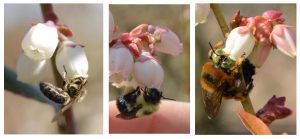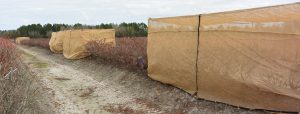Florida Blueberry Industry
Blueberry growers in central and south Florida mostly utilize the highbush blueberry (Vaccinium corymbosum). It does not require many chill hours (the necessary number of hours where temperatures fall between 32 and 45 degrees F during which the plants are dormant) and it produces fruit in late winter/early spring. This production early in the year allows Florida growers to monopolize the market during that time period.

Blueberries require cross-pollination with a different cultivar of the same species to produce fruit. Not only does cross-pollination of cultivars cause fruit development but also increased berry size and faster ripening. Currently, the majority of Florida blueberry growers utilize honey bee (Apis mellifera) colonies and some use commercial bumble bees (Bombus impatiens) for pollination services. Both honey bees and bumble bees have been shown to be efficient pollinators of blueberry.

The Value of Bees
In a recent experiment by the UF Honey Bee Lab large mesh cages were used to exclude bumble bees, honey bees, and wild bees from open blueberry blooms. The bushes in these cages yielded less than 10% fruit set in two cultivars of highbush blueberries (Millennia and Emerald). Other cages excluded honey bees and wild bees, but were stocked with commercially produced bumble bee colonies. These bumble bee pollinated flowers yielded similar fruit set to “open cage” bushes which were accessible by honey bee and bumble bee colonies as well as wild bees. The data generated from this experiment shows the value of bee pollination to blueberry growers in Florida.

Have something to say? Join the discussion on our Facebook Page (www.facebook.com/UFHoneyBeeLab/).
 0
0
